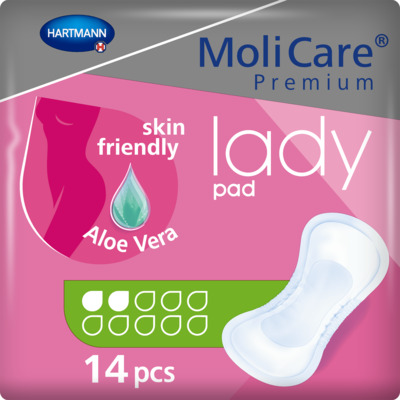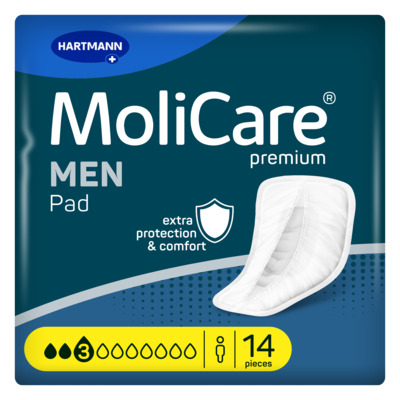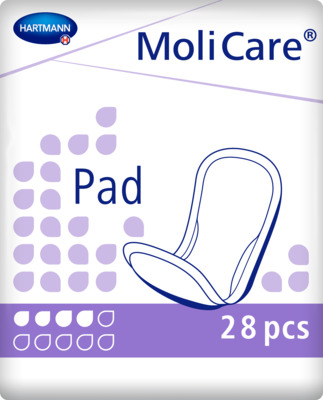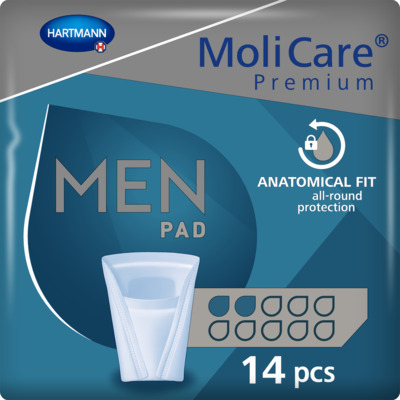Incontinence Advice
Managing Incontinence: Top Tips For A Better Lifestyle
Incontinence can present unique challenges for different people. In this article, we will look at the top tips for managing incontinence effectively to maintain peace of mind and live comfortably and confidently. You will also learn about the various types of incontinence, their symptoms, and potential causes. With over 40 years of experience, HARTMANN Direct are proud to be the home of MoliCare® incontinence products. Our products are suitable for different kinds of incontinence needs, and only by using them can you be fully equipped for the challenges that incontinence may bring/

Types of Incontinence
Learning about incontinence and its different forms can help you manage and even prevent it. Understanding these types will help you determine the help you need, and what to discuss with your healthcare professional.
Bowel Incontinence:
Bowel incontinence is a loss of control over the bowel, which can lead to unintentional bowel movements. This can be a distressing and embarrassing issue for those who experience it. For further information, read our bowel incontinence guide, which goes into further detail about this condition.
Urinary Incontinence:
Urinary incontinence is a loss of control over the bladder, resulting in unintentional urine leakage. This condition can vary in severity, from occasional mild leaks to more significant problems. Again, we have another article that goes into further detail and delves into the causes of urinary incontinence.
Types of Urinary Incontinence:
There are different subtypes of urinary incontinence, but the two most common are:
Stress incontinence: This can occur when there is increased pressure on the bladder. Any additional pressure, such as sneezing, coughing, or laughing, can cause urine to leak. Stress incontinence in women is a common condition, as this can be linked to life events like childbirth and menopause.
Urge incontinence: An overactive bladder is the main cause of urge incontinence. It manifests as a sudden, strong urge to urinate, which can be difficult to control. Those who struggle with urge incontinence may not always make it to the toilet in time, resulting in accidents. Therefore, it is important to consider how often you should wee, and, if you are visiting the toilet over eight times a day, it could be a sign of urge incontinence.
Causes of Urinary Incontinence:
Urinary incontinence has a variety of causes, including:
Weakened pelvic floor muscles.
Overactive muscles that control the bladder.
Altered nerves that control the bladder or pelvic floor.
An enlarged prostate.
Being overweight.
Damage from childbirth or surgery.
Taking certain medications.
Certain health conditions that affect the brain or nervous system, e.g., Parkinson's or Multiple Sclerosis (MS).
Symptoms of Urinary Incontinence:
Symptoms of incontinence can vary widely from person to person. Some may experience occasional mild leaks, while others may face more severe challenges.
-
Leaking urine during everyday activities such as coughing, sneezing, laughing, or exercising.
-
Inability to hold on to urine until reaching the toilet.
-
Frequent or urgent need to urinate.
-
Leaking urine without any warning or urge.
-
Bedwetting during sleep.
Causes of Bowel Incontinence:
On the other hand, bowel incontinence can be caused by:
Weakened or impaired bowel muscles.
Alterations in the nerves that regulate bowel function.
Persistent and severe diarrhoea.
Prolonged and severe constipation.
Gastrointestinal disorders such as irritable bowel syndrome (IBS), Crohn's disease, or haemorrhoids.
Additionally, certain medical conditions, such as Parkinson's, stroke, or Alzheimer's, can contribute to bowel incontinence caused by the condition itself.
Symptoms of Bowel Incontinence:
- Inability to hold on to a poo until reaching the toilet.
- An urgent and uncontrollable need to have a bowel movement.
- Leaking some poo when passing wind.
- Soiling yourself without realising.
Make Dietary Changes:
Certain foods and drinks can irritate the bladder and bowel, which can, in turn, worsen incontinence. These include the following:
- Caffeine.
- Alcohol.
- Acidic fruits and fruit juices.
- Tomato-based foods.
- Chocolate.
- Fizzy drinks.
- Spicy foods.
Reducing or eliminating these items from your diet can help you manage incontinence better. Start by avoiding them for a week or two, then gradually reintroduce them to identify triggers. Alternatively, opt for bladder-friendly drinks instead.
We have also listed some alternative methods on how you can better manage incontinence below.
Our top tips on managing incontinence
- Types Of Incontinence
- Bowel incontinence
- Urinary incontinence
- Types of urinary incontinence
- Causes of Urinary Incontinence
- Urinary Incontinence Symptoms
- Causes Of Bowel Incontinence
- Bowel Incontinence Symptoms
- Sources
- Make Dietary Changes
- Stay Hydrated
- Try Pelvic Floor Exercises
- Stay Active
- Incontinence And Skin Care
- Manage Your Medications
- Keep A Bladder Diary
- Train Your Bladder
- Avoid Lifting And Lose Excess Weight
- Manage Incontinence with MoliCare
- FAQs
Stay Hydrated
Although cutting certain drinks and foods out of your diet can help you manage incontinence, you must stay hydrated. Drinking plenty of fluids, especially water, is vital when you have incontinence. Not drinking enough water can lead to more concentrated urine, which is more likely to irritate the bladder and reduce its capacity. Also, it can lead to dehydration. Unfortunately, these can make incontinence symptoms worse.
So, you should aim to drink
plenty of water every day. The NHS recommends drinking at least 6-8 cups or
glasses of fluids a day, including water, low-fat milk and sugar-free drinks.
To ensure you are drinking the right amount, try keeping a water bottle with
you throughout the day, as you will find yourself drinking much more when it is
readily available to you.
Try Pelvic Floor Exercises
It is possible to combine sports with incontinence. After all, weak pelvic floor muscles can lead to incontinence. Pelvic floor exercises, such as Kegel exercises, help to strengthen these muscles. You can locate your pelvic floor muscles by squeezing to stop urine from coming out, but it is important not to practice pelvic floor exercises when passing urine. Consider the following exercise method:
Sit comfortably and relax your stomach and thighs.
Squeeze your pelvic floor muscles for up to ten seconds, then release.
Continue for ten squeezes.
Repeat these two to three times a day.
Gradually increase the squeeze duration.
Consistency yields results within months.
You can check out more information at: what are pelvic floor exercises?
Read More: Incontinence During & After Pregnancy
Stay Active
As well as working on exercising your pelvic floor, keeping your whole body active through regular physical activity can help manage incontinence symptoms. Not only will staying active help relieve symptoms of incontinence, but it will also make you feel happier and healthier overall, better preparing you to manage your incontinence.
So, try integrating some low-impact exercises into your regular routine. For example, you could try moderate activities such as brisk walking, swimming, cycling, pilates and yoga. Aim for at least 30 minutes of these moderate, low-impact exercises and see which ones help manage your incontinence.
Find Suitable MoliCare Products
In several clicks find out how we can help you
Find a product Find Suitable MoliCare ProductsIncontinence And Skin Care
Incontinence can lead to skin issues, which can only worsen your incontinence experience. Therefore, you should opt for skin care products to maintain your wellbeing and, of course, protect your skin. We recommend the below products:
- Clean and dry thoroughly after urinating or having a bowel movement, using MoliCare skin cleansing products.
- Apply MoliCare skin barrier cream.
Using these products will make your incontinence and toiletry experiences easier and more pleasant to handle.
Manage Your Medications
Certain medications can cause and worsen incontinence symptoms, so you should be aware of your medications. Drugs that can contribute to incontinence symptoms and bladder control issues include:
● Heart medications
● Drugs to control high blood pressure
● Muscle relaxants
● Antihistamines
● Diuretics
● Antidepressants
●
Sedatives
You should consult with your
doctor immediately if you are experiencing incontinence or difficulty when
urinating while taking any of these drugs. Your doctor may advise you to stop
taking these medicines with their monitoring or provide you with an alternative
that will help you.
Keep A Bladder Diary
Keeping a bladder diary is a
fantastic idea, as it will show you how often you’re going to the toilet and
help you determine any patterns. Over the course of several days, you can
record how much you drink and how often you go to the toilet. Additionally, you
may also want to make a note of the amount of urine produced and the number of
incontinence incidents. Once you have completed your diary, you can discuss the
results with your doctor, who will be able to give you further insights and
help you determine the next steps.
Train Your Bladder
Frequent toilet trips can train your bladder to send premature signals to urinate in case you usually struggle to do so. Note: bladder training isn’t needed if you visit the toilet every three to four hours. However, visiting the toilet every ten, fifteen, or even thirty minutes can be a cause for concern. Strengthening the pelvic floor will reduce the need to visit the toilet as frequently. Therefore, use the following bladder training methods:
Determine Your Toilet Pattern: Keep a bladder diary to establish frequency and to monitor progress.
Increase Time Between Toilet Breaks: Gradually add fifteen minutes between trips until you reach two-to-four hourly intervals.
Stick to Your Schedule: Employ distraction techniques if needed to stay on schedule.
Avoid Lifting And Lose Excess Weight
When dealing with incontinence, you must minimise putting strain or pressure on your pelvic floor muscles such as by avoiding heavy lifting.
Excess weight can also worsen incontinence due to it placing pressure on the bladder. Instead, adjusting your diet and losing weight can lead to fewer incontinence symptoms and make the condition easier to handle. Consult a practice nurse or a health nutritionist to see how you can adjust your diet to lessen the effects of incontinence.
Manage Incontinence With MoliCare
While incontinence is a condition that does not disappear overnight, integrating these tips into your day-to-day routine can gradually lessen the effects of the condition and enable you to manage incontinence better. By knowing the different forms of incontinence, performing pelvic floor exercises, bladder training techniques, and optimising skin care in your toiletry routines, you will be more capable of managing incontinence to improve your quality of life, and enhance your overall well-being. At HARTMANN Direct UK, we pride ourselves on offering the best quality products for managing incontinence, leading to a more comfortable lifestyle.
FAQs
What is the best thing to do for incontinence?
The best approach depends on the cause. Options include lifestyle changes, Kegel exercises, medications, behavioural therapies, medical devices, or surgery, tailored to the individual's needs.
Can incontinence be managed?
Yes, it can often be managed through lifestyle adjustments, exercises, medications, and therapies. Consultation with a healthcare professional is key for personalised management.
What are the four types of incontinence?
The four main types are stress, urge, overflow, and mixed incontinence. They vary in causes and require specific management approaches.
Sources
NHS. (n.d.) What are pelvic floor exercises. [online] Available at: https://www.nhs.uk/common-health-questions/womens-health/what-are-pelvic-floor-exercises/ [accessed 30/10/23]




